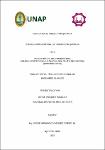Obtención de biocombustible sólido a partir de la cáscara del fruto de castaña (Bertholletia excelsa)

View/
Date
2022Author
Vasquez Vasquez, Jorge
Ríos Arimuya, Andreus Jhonatan
Metadata
Show full item recordAbstract
The objective of this work was: to obtain solid biofuel from the shell of the chestnut fruit (Bertholletia Excelsa) in order to rescue this existing solid residue in local markets and be used as an input in the generation of heat energy, necessary in the various productive activities. The work carried out has a explicative quantitative approach. The study population was constituted by the shells of the chestnut fruits (Bertholletia Excelsa) obtained in the markets of the nativity scene of the city of Iquitos, the type of sampling is random at the discretion of the researchers, considering the size of the sample. a maximum of 3Kg (1500 g. Nativity Market, 1500 g. Model Market). The results obtained from the 2 samples analyzed, from the Belén and Modelo markets, resulted in the following average values of calorific value M1: 12,939 kcal/kg, M2: 4,663 kcal/kg, M3: 7,581 kcal/kg, which correspond to 6 tests performed for each sample respectively. In conclusion, it was shown that a solid biofuel can be obtained in the form of briquettes with chestnut shells with a high calorific value compared to biofuels from other fruit residues. El presente trabajo tuvo como objetivo: obtener biocombustible solido a partir de cáscara del fruto de castaña (Bertholletia Excelsa) con la finalidad de rescatar este residuo solido existente en los mercados locales y sean utilizados como insumo en la generación de energía calorífica, necesarias en las diversas actividades productivas. El trabajo realizado tiene enfoque cuantitativo explicativo. La población de estudio, estuvo constituido por las cáscaras de los frutos de castaña (Bertholletia Excelsa) obtenidos en los mercados de belén de la ciudad de Iquitos, el tipo de muestreo es al azar a criterio de los investigadores, considerándose el tamaño de la muestra un máximo de 3Kg (1500 g. Mercado belén, 1500 g. Mercado modelo). Los resultados obtenidos de las 2 muestras analizadas, de los mercados de belén y modelo dieron como resultado los siguientes valores promedio de poder calorífico M1: 12939 𝑘𝑐𝑎𝑙/𝑘g, M2: 4663 𝑘𝑐𝑎𝑙/𝑘𝑔, M3: 7581𝑘𝑐𝑎𝑙/𝑘𝑔 los cuales corresponden a 6 pruebas realizadas para cada muestra respectivamente. En conclusión, se demostró que se puede obtener un biocombustible solido en forma de briquetas con cáscaras de castaña con un alto poder calorífico comparado con biocombustibles de otros residuos de frutos.
Collections
- Tesis [198]

